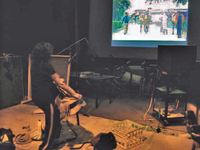![]() I have the pleasure of sharing this great interview with Monique Reymond a top Hollywood Foley artist. Monique was nominated for a prime time Emmy award for her work on the TV series "Survivor" (yes -- they Foley Reality TV too, we'll get into that).
I have the pleasure of sharing this great interview with Monique Reymond a top Hollywood Foley artist. Monique was nominated for a prime time Emmy award for her work on the TV series "Survivor" (yes -- they Foley Reality TV too, we'll get into that).
And this year she won a 2008 Golden Reel Award for her work on the animated series "SpongeBob SquarePants." She is also the proud recipient of a 2008 Emmy for Outstanding Individual Achievement in a Craft: Music and Sound -- "America at a Crossroads / PBS Operation Homecoming: Writing the Wartime Experience' for her outstanding Foley work. If you click her name above you can find a link to her IMDB page and although it is not complete you will find it to be exhaustive.
WOODY: How do you define Foley?
MONIQUE: I sit in a room with a microphone and an engineer records me making sounds for use in television or film. At a minimum, I cover all of the human sounds, by this I mean footsteps, hand pats and grabs, and props that the folks onscreen handle. This does not preclude animal sounds, we do animal footsteps and movement as well. There are sounds that are covered mainly by foley, and others by a sound editor that may be cut from a library. Who covers what is dictated by: time, budget and available resources.
Sometimes, both Foley and effects will cover a particular sound and the re-recording mixer will use a combination of both. If it's a big sound like a car crash, our tendency in Foley is to cover the debris from the crash as opposed to the actual impact, which a sound editor would cut in as a hard effect. If I have the time I may help the impact along, but I won't be able to get as large of a sound as an editor can cut in from a library. We don't generally do sounds like engines or motorized sounds.
INTERVIEW: Monique Reymond – Foley Artist / Woody Woodhall CAS
WOODY: I think most people would be surprised at the amount of Foley that gets done. How much Foley will you do on a feature? Do you do all the human sounds?
 MONIQUE: On a standard feature we do all of them. Some of the Foley "legends' will do far more than just the human sounds. They will do huge impacts for example, I heard about a foley artist that covered the sound of a train chugging along and screeching to a halt on the tracks for a film that featured a very long train sequence. The fact that they covered the train in foley instead of recording an actual train blew me away.
MONIQUE: On a standard feature we do all of them. Some of the Foley "legends' will do far more than just the human sounds. They will do huge impacts for example, I heard about a foley artist that covered the sound of a train chugging along and screeching to a halt on the tracks for a film that featured a very long train sequence. The fact that they covered the train in foley instead of recording an actual train blew me away.
Part of the reason they can do this is because they are very talented, but also it is because they have a stage that affords them a lot of space and a lot of really great large props, also they have the time to experiment and figure out how to create something as involved as that. They may have a month to do a film, which is generally not the case with me. Usually I do a feature length project in five days. I don't have the time or the resources to experiment with that kind of thing. But it can go far beyond human sounds if you've got time.
WOODY: When you say "legends' you're talking about studio Foley artists and large Foley stages like Warner Bros. or Paramount?
MONIQUE: Exactly.
WOODY: You're doing the Foley for a full-length feature film in five days?
MONIQUE: Five to ten is the most I've been given. Budgets have gotten tighter. ProTools has been really good and bad for the industry. In some ways it's been great because you can redo a take very quickly. In the old days when you were shooting tape everything required a pre-roll. Back then, to redo the slightest thing took twelve seconds just to prepare for that, whereas now, it's instantaneous. If you don't like it you can very quickly redo it. But it's also brought down the budgets because people are doing guerilla Foley in their garages.
